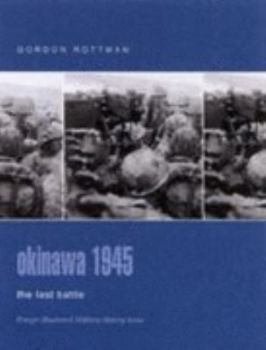Okinawa 1945: The Last Battle (Praeger Illustrated Military History)
(Part of the Osprey Campaign (#96) Series and Osprey Campaign (#96) Series)
Select Format
Select Condition 
Book Overview
By the spring of 1945 the Allies were sweeping all before them in the Pacific War against Japan, and a series of victories had reclaimed many of the islands and territories seized by the Imperial... This description may be from another edition of this product.
Format:Hardcover
Language:English
ISBN:0275982742
ISBN13:9780275982744
Release Date:January 2004
Publisher:Praeger Pub Text
Length:96 Pages
Weight:0.80 lbs.
Dimensions:9.8" x 0.5" x 7.3"
Customer Reviews
2 ratings
Good Coverage of a Long Difficult Campaign
Published by Thriftbooks.com User , 15 years ago
I wish Mr Rottman had ten more pages to fill out the battle action for this battle was so difficult and intriguing with the intense defense, the difficult terrain, the Kamikaze attacks etc that I'm sure the author was confined by the page limit. If it was possible, I would have strayed from traditional format and eliminated the couple 2 page color illustrations for more room for the battle. The introduction was very good and helped set the scene for the landing and subsequent engagement. The chapters on Opposing Commanders and Opposing Forces were also excellent but it will take away from describing the 3 month battle. There was only 33 pages devoted to the battle while other Osprey books can have 50 pages or more. This really short changed the battle action. The photos were very good; they helped show the difficult terrain our marines and soldiers had to contend with while fighting the enemy. Most of the maps were good as well, especially the three 3-D maps. Once again, these maps help show the terrain and the relative positions of the terrain obstacles. Within page limits, Mr Rottman has done a good job with this book, like he has with his other books, but feel too much time was spent on the prehistory and not enough on the difficult battle. Its still recommended. For further reading Roy Appleman's or EB Sledge's books will add to your understanding of the battle. If you want the absolute best maps of the campaign then you'll need the book by Chas Nichols.
One of the Best of the Campaign Series
Published by Thriftbooks.com User , 22 years ago
Former Green Beret Gordon L. Rottman provides an excellent summary of America's last great amphibious invasion of the Second World War in Osprey's Campaign #96, Okinawa 1945. Quite simply, this is one of the better titles in Osprey's campaign series and shows that it is possible to pack a great deal about a major military operation into a 96-page format. This book is particularly useful as a case study for military officers, thanks to the author's attention to many pertinent details that escape most civilian authors. Overall, Okinawa 1945 is a "must-have" for anyone interested in the later stages of the Pacific War. Although Rottman follows the standard Osprey campaign format, the opening chapters of this volume are far more in-depth than virtually all the other titles in the series. An 11-page introduction covers the history and terrain of Okinawa, as well as the American strategic debate about whether to invade Okinawa or Formosa. The section on opposing plans is also quite detailed, totaling 10 pages. Seven pages are used to cover opposing high-level commanders on both sides. Another 12 pages are used to cover opposing forces, including succinct but detailed discussions of tactical organization and strength and weaknesses of each major unit. Pertinent characteristics are included; such as each US Army division in the invasion was about 1,000 infantrymen under strength due to a shortage of replacements and the fact that one of the two Japanese divisions on the island had no organic artillery. Taken together, Rottman provides a far more detailed introduction to the campaign than any other Osprey title, by spending fully 52% of the volume on the background material. Unfortunately, the strength of the introduction leads to the weakness of the main campaign narrative that - while good - is overly succinct. The invasion itself is covered in 33 pages: sections on the initial landings, the continuing offensive, actions at sea, and the push southward. There are three color battle scenes: Japanese suicide boats at Naha, Marines reducing a bunker and the virtual annihilation of the US 193rd Tank Battalion on 19 April 1945. There are a total of five 2-D maps (strategic situation, Okinawa, the initial landings, the Ie Shima assault, and the withdrawal of the 32nd Army)and three 3-D "Birds Eye View" maps (the Japanese counteroffensive on May 4-6, 1945, the Battle for Sugar Loaf Hill, and the final stand in the south). The author also effectively uses footnotes at the end of each section to provide additional details. Okinawa 1945 has a great many strengths. The author's discussion of terrain and weather (e.g. the impact of rain on operations) greatly enhances the reader's appreciation for the operational environment. Rottman also makes very good use of statistics, particularly concerning military and civilian casualties. For example, I was unaware that 153 of 354 American tanks used on Okinawa were knocked out by the Japanese - a 43% loss






